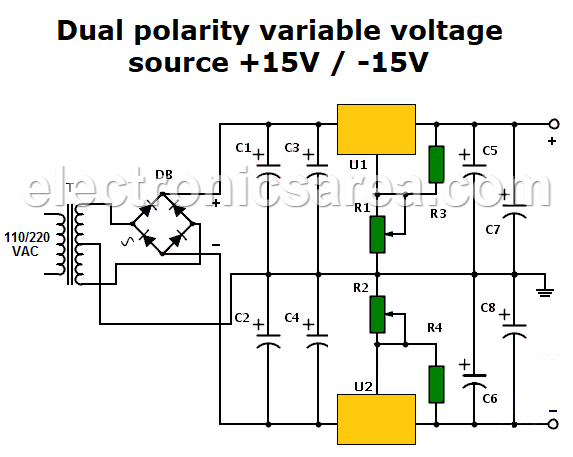Home / Circuits / Power Supply /
Dual Polarity Variable Power Supply
This dual polarity variable power supply provides two independent voltage outputs. One positive and one negative, with a maximum amplitude of +/- 15 volts and a current of up to 1.5 amps.
This power supply is ideal for powering dual polarity circuits, such as some audio amplifiers and op amp applications. If you need a more powerful power source, the 3 Amp variable Voltage Source may be for you.
How Does the Dual Polarity Variable Power Supply Work?
This voltage source uses the LM317 variable voltage regulator for the positive voltage output (from 1.2 to 15 volts) and the LM337 variable voltage regulator for the negative voltage output (from -1.2 to -15 volts). Two potentiometers are used to vary the output voltage. See the diagram.
Dual polarity Variable Power Supply (+15V / -15V) max.
Remember that these regulators have the limitation of not being able to deliver a voltage equal to or less than 1.2 volts in the case of positive voltage output and -1.2 volts in the case of negative voltage output.
To solve this problem, two rectifier diodes (e.g. 1N4003) can be connected in series to the output of each regulator, resulting in a voltage drop of 0.6V + 0.6V = 1.2V.
This will cause the final output to always be reduced by this voltage, and thus deliver “0 volts”, but for most applications this is not a problem. (Diodes are not shown in the schematic)
The electrolytic capacitors: C1, C2, C3, C4 are the filters that flatten the output wave from the diode bridge before it enters each regulator. Capacitors C5, C6, C7 and C8 are used to improve transient response.
Pin Assignments for LM317 and LM337 Voltage Regulators
Every regulator needs a heat sink, the bigger, the better. If the use of the power supply is constant, a fan can be placed to cool the heat sinks.
Dual Polarity Variable Power Supply Components List
- 2 240 ohm / ¼ watt resistors: (R3, R4)
- 2 5K potentiometers (R1, R2)
- 2 2200uF / 35V electrolytic capacitors (C1, C2)
- 4 1uF / 35 Volt capacitors (C3, C4, C5, C6)
- 2 100uF / 35 Volt electrolytic capacitors (C7, C8)
- 1 2 Amp diode bridge (DB)
- 1 LM317 positive voltage regulator (U1)
- 1 LM337 Negative Regulator (U2)
- 2 heat sinks, for U1, U2
- 1 switch to place on primary of transformer
- 1 110/220 to 30VAC, 2 Amp, Center Tapped Transformer (T)






